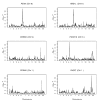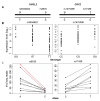Polymorphic cis- and trans-regulation of human gene expression
- PMID: 20856902
- PMCID: PMC2939022
- DOI: 10.1371/journal.pbio.1000480
Polymorphic cis- and trans-regulation of human gene expression
Abstract
Expression levels of human genes vary extensively among individuals. This variation facilitates analyses of expression levels as quantitative phenotypes in genetic studies where the entire genome can be scanned for regulators without prior knowledge of the regulatory mechanisms, thus enabling the identification of unknown regulatory relationships. Here, we carried out such genetic analyses with a large sample size and identified cis- and trans-acting polymorphic regulators for about 1,000 human genes. We validated the cis-acting regulators by demonstrating differential allelic expression with sequencing of transcriptomes (RNA-Seq) and the trans-regulators by gene knockdown, metabolic assays, and chromosome conformation capture analysis. The majority of the regulators act in trans to the target (regulated) genes. Most of these trans-regulators were not known to play a role in gene expression regulation. The identification of these regulators enabled the characterization of polymorphic regulation of human gene expression at a resolution that was unattainable in the past.
Conflict of interest statement
The authors have declared that no competing interests exist.
Figures




References
-
- Brem R. B, Yvert G, Clinton R, Kruglyak L. Genetic dissection of transcriptional regulation in budding yeast. Science. 2002;296:752–755. - PubMed
-
- Yvert G, Brem R. B, Whittle J, Akey J. M, Foss E, et al. Trans-acting regulatory variation in Saccharomyces cerevisiae and the role of transcription factors. Nat Genet. 2003;3:57–64. - PubMed
-
- Emilsson V, Thorleifsson G, Zhang B, Leonardson A. S, Zink F, et al. Genetics of gene expression and its effect on disease. Nature. 2008;452:423–428. - PubMed
-
- Stranger B. E, Forrest M. S, Clark A. G, Minichiello M. J, Deutsch S, et al. Genome-wide associations of gene expression variation in humans. PLoS Genet. 2005;1:e78. doi: 10.1371/journal.pgen.0010078. - DOI - PMC - PubMed
Publication types
MeSH terms
Grants and funding
LinkOut - more resources
Full Text Sources
Other Literature Sources
Molecular Biology Databases
Research Materials
Miscellaneous

